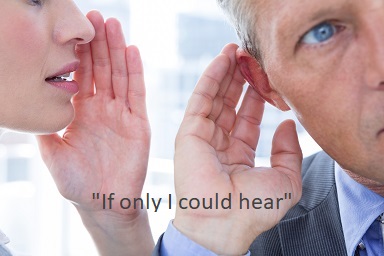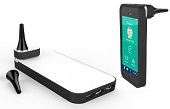Unblock ears, nose and sinuses

Find out what is blocking your ears by
- understanding the likely cause
- borrowing our otoscope to look inside your ears
- unblocking waxy ears or treating sinusitis
with the help of one of our experienced doctors online by email or phone without the need to take time off work to visit a doctor's surgery
Dr Morton's Prescription© for sinusitis
Dr Morton's Test Kit© for allergies
Blocked ears
The causes of a sensation of having blocked ears can be considered anatomically, according to which part of the ear is causing the problem. There are three parts of the ear to think about. The outer or external ear canal on the outside of the ear drum; the middle ear which is the part of the ear between the ear drum and the inner ear; and the inner ear which as the name implies is deep inside and is the link to the brain.
The inner ear can sometimes be affected by viral infections like a cold and although this is rare, when it happens, it can cause nerve deafness. This may feel like a blocked ear. This should be treated urgently with a short course of high dose steroids aimed at reducing the risk of permanent deafness.
The middle ear is the area behind the ear drum (tympanic membrane) which contains bones called ossicles. These tiny bones, the malleus, the incus and the stapes, transmit vibrations of the eardrum caused by sound, into the inner ear. The middle ear has a ventilation tube along which fluid and air can pass into the back of the throat (pharynx). This is called the Eustachian tube and its function is to keep the pressure equal on both sides of the ear drum so that the ear drum and the ossicles are free to vibrate. Normally the Eustachian tube opens when we yawn or swallow and we sometimes notice our ears pop when we do this as the pressure equalises on either side of the ear drum.
When we have a cold the Eustachian tube becomes inflamed and blocked by swelling and mucus. This stops the pressure equalisation making our ears feel blocked and we become temporarily deaf as a result. Sometimes with a cold the stagnant mucus in our blocked ears and Eustachian tubes becomes infected causing severe pain and swelling inside the middle ear which can lead to the drum perforating and a sticky discharge from the ear. This is usually treated with antibiotics to encourage the drum to heal.
Similarly with air travel or going up and down a steep hill or long elevator ride, a difference in atmospheric pressure develops across the ear drum reducing its ability to move and making the ears feel blocked. The usual remedy in this situation is to hold your nose and blow hard to force air through the Eustachian tubes into the middle ear (known as a Valsalva manoeuvre) making the ears pop as the pressure equalises. If the tubes are inflamed and swollen this becomes impossible and the pressure difference across the ear drum tugs on it often causing pain in the ears which can be awful.
The same situation applies during scuba diving if equalisation of the pressure difference is not achieved during descent and ascent. In this case, because the pressure differences can be so large, severe damage (barotrauma) can occur. This can require surgery and may lead to permanent hearing loss.
Ear wax is a different problem altogether. The outer part of the ear naturally produces a waxy secretion, which if it accumulates in hard lumps can lead to temporary deafness by blocking the external ear canal.
Rather than take time off work to visit the doctor for diagnosis using his otoscope, then book one or several return visits for the nurse to wash out your ears, why not borrow our otoscope from Cupris and use it to send our doctors the video for diagnosis, then order Dr Morton’s Prescription© for blocked waxy ears to free wax if needed.
Ear syringing used to be recommended as treatment by some doctors' surgeries but there is a risk of perforation or infection with ear syringing so it has become less popular recently. Regular use (every fortnight or so) of a few drops of olive oil into the external ear canal will often keep the wax from building up and hardening. It is helpful to have Dr Morton’s Prescription© for blocked waxy ears because it comes with a pipette which you can place in the bottle of olive oil for clean storage and less mess after application. There are also some proprietary brands of wax dissolving or softening drops such as Cerumol which can be useful but occasionally cause irritation.
Cupris have designed a nifty otoscope which can be clipped onto an iphone 5 or 6 and the video sent to our doctors for analysis. If you want to borrow our otoscope click here to register your interest and we will send you one as soon as it becomes available.
A word about cotton buds. Many people are in the habit of cleaning their ears or trying to remove wax with cotton buds. This is not recommended because the 'skin' which lines the ear canal and the ear drum itself is very delicate and can be easily damaged leading to infection or perforation of the ear drum. Also, wax is rarely successfully removed in this way and more often is impacted against the ear drum making deafness worse and the wax itself harder to remove.
The external ear canal can also be blocked by debris from an infection in its own lining. This is known as otitis externa or swimmer's ear. This causes an itchy or sometimes very painful blocked ear and fluid discharge. Treatment is usually with drops which contain a mixture of antibiotics and anti-inflammatory steroids.
Sinusitis explained
Sinuses are spaces that develop as out-pouches from the lining of the nose into the bones of the cheeks and brow. They are almost absent at birth but expand rapidly when your adult teeth erupt, and again at puberty. There are three groups of para-nasal sinuses:
- frontal sinuses – two sinuses found just above the eyes towards the centre of the face
- ethmoidal sinuses – a group of small sinuses found between the eyes and behind the bridge of the nose
- maxillary sinuses – found beneath the eye socket and above the upper row of teeth
When the lining of these sinuses is inflamed, more mucus is produced, and if the drainage channel from the sinus to the nose becomes blocked, high pressure develops inside these small spaces giving severe pain. Typically if you bend forward the pain is worse making you want to hold your brow and face. Stagnant mucus makes bacterial infection more likely (acute sinusitis) and subsequent chronic inflammation (chronic sinusitis) may follow.
Sinusitis can be
- acute: an infection lasting several days (usually viral)
- subacute: inflammation lasting several weeks
- recurring: >3 acute episodes in a year
- chronic: symptoms carry on indefinitely
Available treatments
Decongestant drops for example Otrivine can be useful for short term (7 days max) relief of sinusitis and blocked ears associated with colds. They are also useful for air travel in those whose Eustachian tube becomes easily blocked. They work by reducing the blood supply to the delicate lining of the nose which reduces swelling temporarily. Long-term use with consequent frequent restriction of the blood supply is not recommended, as it could damage the nose lining and can cause a condition called rhinitis medicamentosa. This is difficult to treat so best avoided.
Pseudoephedrine tablets (Sudafed) and other products which contain paracetamol and a decongestant like Lemsip and Beechams powders are also helpful. Nightnurse contains an antihistamine which is sedating and something to suppress a cough and this can also be helpful if sleep is a problem.
Other conditions can give similar symptoms such as
- common cold
- chest infection
- influenza
- allergic rhinitis
When should you contact a doctor
- if your medication isn’t working effectively
- if your eyelid or cheek becomes red and swollen – this could indicate a bacterial skin or tissue infection known as cellulitis
Acute sinusitis
Acute sinusitis usually follows an upper respiratory tract infection with a virus. The most common viruses are rhinoviruses (cold viruses), coronaviruses and influenza viruses, although a myriad of others may be involved. If the infection is bacterial the most common culprits are Streptococcus pneumoniae, Haemophilus influenzae and Morazella catarrhalis. Viral sinusitis usually clears in 7-10 days whereas bacterial tends to be more persistent and needs treatment with antibiotics. Allergies can also lead to irritation of the membranes in the nose and sinuses. Fungal sinusitis is rare in people with fully functioning immune systems but it occurs in those with immune deficiencies such as HIV or people on immunosuppressive medicines, or those with diabetes. Rarely tooth root abscesses can rupture into a sinus. Chemical irritation from substances such as chlorine in swimmers, tobacco smoke or inhaled drugs such as cocaine can also cause sinusitis.
Chronic sinusitis
Chronic sinusitis lasts longer than three months and has a variety of causes. It can be difficult to diagnose because the symptoms of chronic sinusitis can be vague and each have other possible causes. Anatomical anomalies or nasal polyps can block the drainage of the sinuses causing chronic problems. Sinus surgery can be useful.
Rare causes include
- cystic fibrosis
- cancers
- sarcoidosis
- Wegener’s granulomatosis
- immotile cilia syndrome
Symptoms of acute sinus infection
- a cold that won’t get better or keeps getting worse
- facial pain or a feeling of pressure over the affected sinus
- fever
- smelly yellow or green nasal discharge
- poor response to nasal decongestants
Symptoms of chronic sinus infection
- nasal congestion
- headaches
- night-time coughing
- increased symptoms of previously controlled asthma
- dizziness
- halitosis (bad breath)
- aching teeth
Diagnosing sinusitis
Usually symptoms are enough to diagnose simple cases of sinusitis. If your sinusitis is very severe or recurs you may need referral to an ear, nose and throat (ENT) specialist who will look for an underlying cause. They may use a small flexible camera (endoscope) to look inside your sinuses. A computerised tomography (CT) scan may also help to find out what is causing the problem.
Available treatments
Most acute sinusitis cases don’t need medical treatment. Viral infections will clear up on their own but can take over two weeks to resolve; this is longer than the common cold. Over-the-counter pain killers and decongestants will help you feel better in the meantime. Proprietary sea salt douches such as Sterimar are simple to use and are often advised by ENT surgeons to flush out congested sinuses and allow secretions to drain. If symptoms don’t improve after a week or if you feel that you are getting worse rather than better you may need treatment. Antibiotics, steroid sprays or drops are all used to treat sinusitis but these will be prescribed by a doctor depending on your personal needs. In rare cases of very severe sinusitis, drainage of the sinuses may need to be surgically improved but this is unusual and only done when absolutely necessary.
Want to know more?
Related topics
← back to treat colds, coughs and flu


